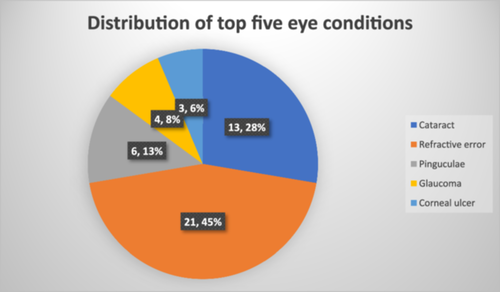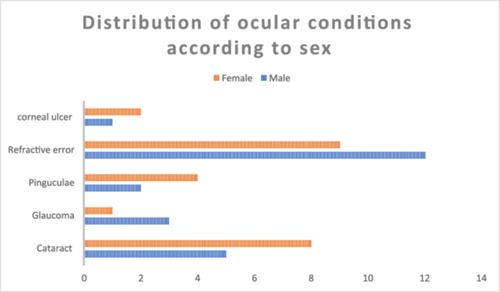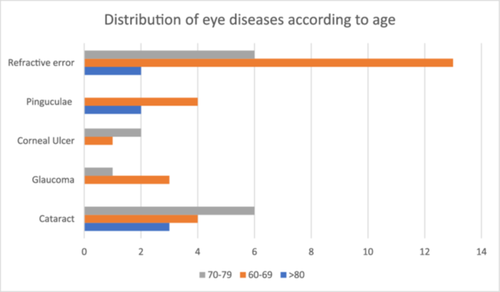Ophthalmological conditions among elderly patients attending a private eye care facility in Malawi: A retrospective study
Abstract
Background
The elderly comprises the fastest-expanding age group globally, with the greatest increase occurring in developing countries. The elderly populace is prone to develop various ocular morbidities.
Purpose
To determine the distribution of ocular morbidities among the elderly population visiting a private eye care facility in Malawi.
Methods
This was a retrospective cross-sectional study conducted at St. John's Hospital in Mzuzu, Malawi. We retrieved data from the hospital's ophthalmic outpatient registry from January, 2021 to December, 2021. A nonprobability census sampling technique was used to retrieve 52 elderly patients. Data analysis were done employing SPSS (v.26).
Results
This study found according to gender a larger proportion were females 27 (51.9%) compared males, who accounted for 25 (48.1%). Refractive error 21 (40.4%) was the most prevalent ocular morbidity followed by cataract 13 (25.0%), pinguecula 6 (11.5%), and glaucoma 4 (7.7%). Although clear differences exist in the distribution of ocular morbidities according to sex (p = 0.529) and age (p = 0.328), the differences are not statistically significant.
Conclusion
The pattern of eye diseases is typical to the country. More resources should be targeting main causes of preventable blindness including refractive error and cataracts at the facility.
1 INTRODUCTION
Globally, ocular morbidities have emerged as a major public health concern with enormous adverse impacts on the human health, productivity, and economy of the individual, family, and nation.1 The frequency of eye morbidities increases at around 40 years of age and reaches a peak at 60 years of age.2 Despite the fact that the elderly population is prone to develop various ocular morbidities,3 they are however an often-neglected populace in terms of health care service delivery especially as it pertains to these ocular morbidities.4 Noteworthy, eye morbidities among the elderly continue to receive less attention and priority in most developing countries.1, 5
The proportion of the world's population over 60 years will nearly double from 12% to 22% from 2015 to 2050.6 Likewise, Malawi's elderly population is on the rise such that those aged over 60 will be >1 million by 2030 and >2 million by 2050.7 However, the healthcare system in Malawi is constrained,8 and may not adequately support the eye care needs of the growing elderly population which constitutes the majority of the patients that may be seen in eye clinics.9 Approximately, 65% of people above 60 years are visually impaired, while 4% are blind. In Malawi, the prevalence of blindness among adults aged above 40 is estimated at 3.7%.10
The pattern of ocular disease varies from country to country and even in the same country from district to district.11 Previous studies have assessed the distribution of eye diseases at government hospitals,8, 12, 13 however, there is no baseline data on the pattern of ocular morbidity among the Malawian elderly visiting nongovernment facilities. In Malawi, health services are provided for free at government facilities while private for-profit and private nonprofit organizations charge fees.14 The nonprofit organization comprising of facilities under the Christian Health Association of Malawi (CHAM) accounts for 37% of all health services.
CHAM facilities provide about 15% of eye care services in the country.15 To plan and implement strategies to tackle eye care conditions one needs to allocate adequate resources as per the needs of the population.16 Therefore, this study aims to describe the pattern of ocular morbidities among the elderly attending a private not-for-profit hospital in Malawi. The information is relevant for policymakers, healthcare managers, and planners to consider strengthening the eye health system to accommodate the eye care needs of this growing population.
2 METHODS
This retrospective study was conducted at St. John's Mission Hospital located in Mzuzu, Northern Malawi. This is one of the private not-for-profit faith-based hospital organized under CHAM.14 The facility runs an outpatient Ophthalmology department where patients are attended to by Optometry Technicians and Ophthalmic Clinical Officers.
The study reviewed patient records at the Ophthalmology department obtained from the hospital archive selected using a census sampling technique. We included patient files from January, 2021 to December, 2021. Files with missing variables were excluded from the study. We recorded the patients' age, sex, and diagnosis on a preform. Age was recoded into age groups to allow for analysis. Furthermore, recoded all other ocular conditions into a variable called “others” which consisted of the least frequent conditions.
2.1 Data analysis
We entered the data in Statistical Package for Social Sciences version 26. We conducted descriptive statistics employing mean and standard deviation, percentages, and frequency. The difference between means was assessed by applying an independent t-test. We examined the association between variables by employing the Chi-square technique. We illustrated the data diagrammatically using pie charts, and graphs. We considered the value of p < 0.05 statistically significant.
2.2 Ethics
Approval for the study was obtained from Mzuzu University Faculty of Health Sciences Research Committee. We got permission to access the patient files from the hospital director of St John's Hospital and the facility in charge. The study adhered to the declarations of Helsinki as such we maintained anonymity by utilizing codes to identify patient files. No patient was harmed during the study.
3 RESULTS
Out of the 52 elderly patients, 25 (48.1%) were males while 27 (51.9%) were females. The mean age was 70.42 (SD = 8.705). The mean age was 70.52 (SD = 10.063) among males and 70.33 (SD = 7.427) among females. According to independent t-test, the difference in age between males and females was not statistically significant t (50) = 0.77, p = 0.939.
The most frequent age group was 60–69 years and the least were greater than 80 years.
3.1 Distribution of common ocular conditions among elderly
The most common ocular morbidity was refractive error 21 (40.4%) followed by cataract 13 (25.0%), pinguecula 6 (11.5%), and glaucoma 4 (7.7%) (Figure 1).

3.2 Prevalence of eye conditions according to sex
The prevalence of refractive was higher among males 12 (57%) than females 9 (43%). Corneal ulcer was high among females 2 (75%) than males 1 (25%). Pinguecula was common among females 4 (67%) than males 2 (33%). Majority of males 8 (61%) had cataracts compared to females 5 (39%) (Figure 2). However, the difference according to sex was not statistically for all the conditions (p = 0.529).

3.3 Prevalence of common ocular conditions based on age
Refractive error was common among those aged 60–69 13 (46.4%) and it was less common in those above 80 years 2 (25%). Likewise, pinguecula and glaucoma were more frequent in the age group 60–69. Cataract and corneal ulcer were common in the 70–79 age group (Figure 3). Nevertheless, the association between age and ocular condition was not statistically (p = 0.328).

4 DISCUSSION
Visual impairments are known risk factor for falls among the elderly, unfortunately visual impairment is left untreated among the group.7 Although we did not assess the prevalence of visual impairment, refractive and binocular conditions were the most frequent diseases in disagreements with previous research.17 We attribute the difference to the higher availability of medical products in CHAM hospitals compared to government hospitals.18 On the other hand, CHAM facilities could be beneficiaries of generous donations of corrective glasses through church donations and could be a pulling factor for patients with refractive conditions. Noteworthy, Malawi does not have local manufacturers of eye health products and technologies.15 In part, it could be because of the socioeconomic profile of the patients attending eye clinics at private hospitals. Our study did not capture the sociodemographic information to investigate this phenomenon, however previous studies have shown a strong link between refractive error and high socioeconomic status.19 The results of our study highlight the need to address access to refractive error services through modern techniques such as teleophthalmology since the elderly have associated mobility issues which may be exacerbated by transport costs hence teleophthalmology can mitigate distance barrier.16 Furthermore, the study recommends a social security system for the elderly that should include corrective glasses to curb visual impairment due to Refractive error. Research suggests that refractive errors are associated with reduced quality of life.20
Our study found that Cataracts are the second common ocular disorder in contrast to a previous study12 which found that cataract was a common ocular morbidity. The difference can be explained by differences in eye care staff composition between the two study settings. Eye care Specialists such as Cataract surgeons and ophthalmologists are available in most government hospitals and nearly nonexistent in private hospitals. Noteworthy, Malawi has one hospital facility under CHAM which provides specialized eye care services including cataract surgeries.15 The unavailability of cataract services under CHAM hospitals could be a barrier to the uptake of cataract services. The findings of this paper call for scaling of eye care services by CHAM facilities to improve blindness against cataracts by including a team of eye care practitioners comprising ophthalmic nurses, cataract surgeons, ophthalmic clinic officers, ophthalmologists, optometry technicians, and optometrists.
In the present study, there was no statistically significant association between eye diseases and sex contrary to what was reported by other studies.20, 21 In contrast, a study done in India found that the prevalence of all ocular morbidities was significantly associated with increasing age.22 Physiologically, eye care conditions increase with age.23 Again, the results of our study can be due to the small sample size and narrow age range employed.
In this present study, more females than males visited the clinic with ocular morbidities similar to the pattern observed at a government health facility in the district.12 In contrast, Kang and colleagues found that more males attend eye care services in Kasungu, Malawi.8 We attribute the difference to variation in the sample composition among the studies. The study conducted in the central region of Malawi, included a wider age range, unlike our review which focused on elderly individuals. The results of our study are surprising considering that more males unlike females have health insurance in Malawi.14 In addition, males have an upper hand over females in terms of financial opportunities in the face of out-of-pocket expenditure associated with private hospitals.24 Our study suggests targeted behavioral change toward men to encourage the utilization of eye healthcare services among men within the catchment area. Equity in access to eye health should be addressed if we are to attain Universal health coverage by preventing the systematic exclusion of vulnerable individuals.21
5 LIMITATIONS
The study is not without drawbacks. First, the study findings should be applied with caution as it is a mono centre, hospital-based and retrospective study with a small sample study. In addition, the nature of the study prevented us from conducting rigorous analysis including the effect of socioeconomic characteristics on the prevalence of diseases. Moreover, our study did not assess the magnitude of visual impairment.
6 CONCLUSION
The most prevalent ocular morbidities highlighted in this review are major causes of preventable blindness. Therefore, robust intervention must be innovated to target refractive errors, cataracts, and glaucoma among the group to improve the quality of life for the elderly. Again, these conditions must be covered by the essential health care package as priority for the senior citizens. Further studies can assess the distribution of refractive error and the adoption of corrective glasses among the elderly. In addition, it remains unclear whether health insurance in Malawi is associated with eye health-seeking behavior.
AUTHOR CONTRIBUTIONS
Owen Banda: Conceptualization; formal analysis; methodology; visualization; writing–review and editing; writing–original draft. Grace Ogbonna: Conceptualization; project administration; supervision; writing–review and editing. Thokozani Mzumara: Conceptualization; investigation; methodology; formal analysis; supervision; visualization; writing–original draft; writing–review and editing.
ACKNOWLEDGMENTS
The authors have nothing to report.
CONFLICT OF INTEREST STATEMENT
The authors declare no conflict of interest.
ETHICS STATEMENT
The study was approved by Mzuzu University Faculty of Health Sciences Research Committee. We got permission to access the patient files from the hospital director of St. John's Hospital and the facility in charge.
TRANSPARENCY STATEMENT
The lead author Thokozani Mzumara affirms that this manuscript is an honest, accurate, and transparent account of the study being reported; that no important aspects of the study have been omitted; and that any discrepancies from the study as planned (and, if relevant, registered) have been explained.
Open Research
DATA AVAILABILITY STATEMENT
The data that supports the findings of this study are available upon request from the corresponding author.




